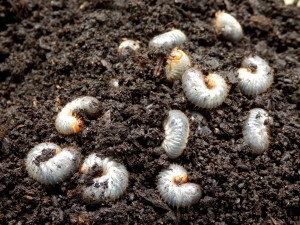September 8, 2017
Flea season usually lasts from late spring into the autumn, and all that time your home will be vulnerable to an infestation. Below, you’ll learn various ways to eliminate fleas and prevent them from returning to your yard.
 The Nature of Fleas
The Nature of Fleas
Fleas are reddish-brown insects measuring a couple millimeters in length, and they suck the warm blood of hairy animals like dogs, cats, mice, and rabbits. They can jump anywhere from 8 to 12 inches at a time, giving the impression of flight. They breed in shady, damp places like trees, shrubs, thatch, and leaf piles.
Fleas won’t just leave their host with itchy bites. They can also:
- Spread internal parasites like tapeworms
- Trigger allergies in humans
- Transmit diseases like plague and typhus
If your pets are scratching themselves more than usual, you can check for signs of bites, which include red, broken skin, infections, and hair loss. Fleas can only lay eggs after feeding, and they usually look like grains of salt. Their feces resemble black pepper.
Prevent an Infestation
You can trim your shrubs, rake the leaves, and remove excessive thatch, decayed wood, and other debris, but that’s only the beginning when it comes to preventing an infestation. There are several measures to consider, such as:
- Monitoring your pet’s outdoor activities
- Using a flea comb on a regular basis
- Spreading cedar mulch around shady spots
Try to keep your pet in the sunlight and out of those shady areas. Fleas are attracted to high (as in 70% or more) humidity, so on those days, you might want to keep your pet indoors. After every excursion, comb your pet’s hair and switch to a flea comb once you get the tangles out; this will trap and remove adult fleas, eggs, and “dirt” (feces).
Other ways to protect your pet include oral medicines and flea collars. Make sure that your pet has no allergies to the collar, though.
Mulch made from cedar can repel fleas because of their odor. By having this in the moist places, it can push the insects into the sunlight, debilitating them.
You Can Stop Fleas
Note that in any infestation, adult fleas only make up about 10% of the population. The other 90% are composed of eggs, larvae, and pupae, which the adult fleas will tuck away in dark places: for example, under the furniture, carpeting, and your pet’s bedding. Here are some ways to address an infestation:
- Vacuuming up the fleas
- Spreading diatomaceous earth
- Spreading nematodes in the dirt
Just vacuuming your carpets can remove a lot of the fleas since they can’t distinguish the fabric of carpets from hair. You’ll have to seal the bag and throw it away afterward, though. Diatomaceous earth will kill fleas by dehydrating them. Nematodes are worms that you can insert into the soil of your lawn; they feed on flea eggs and larvae.
If these methods prove insufficient, you’ll want to call a pest control company. You can also ask a professional landscaper about ways to make your yard less appealing to these insects.
Gallery
“We recommend Twin Oaks to any entity looking for a full-service, talented, and responsive provider.”
